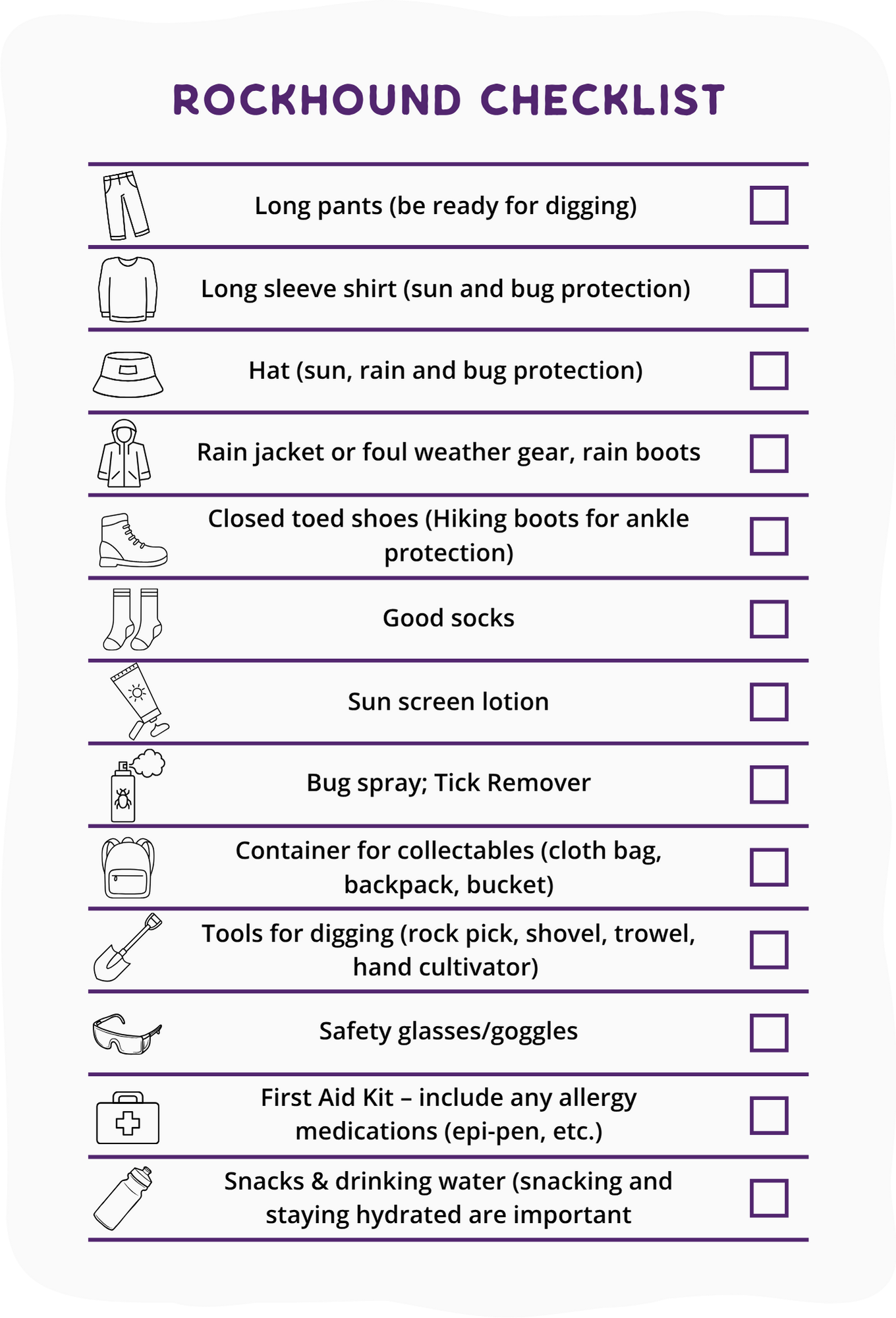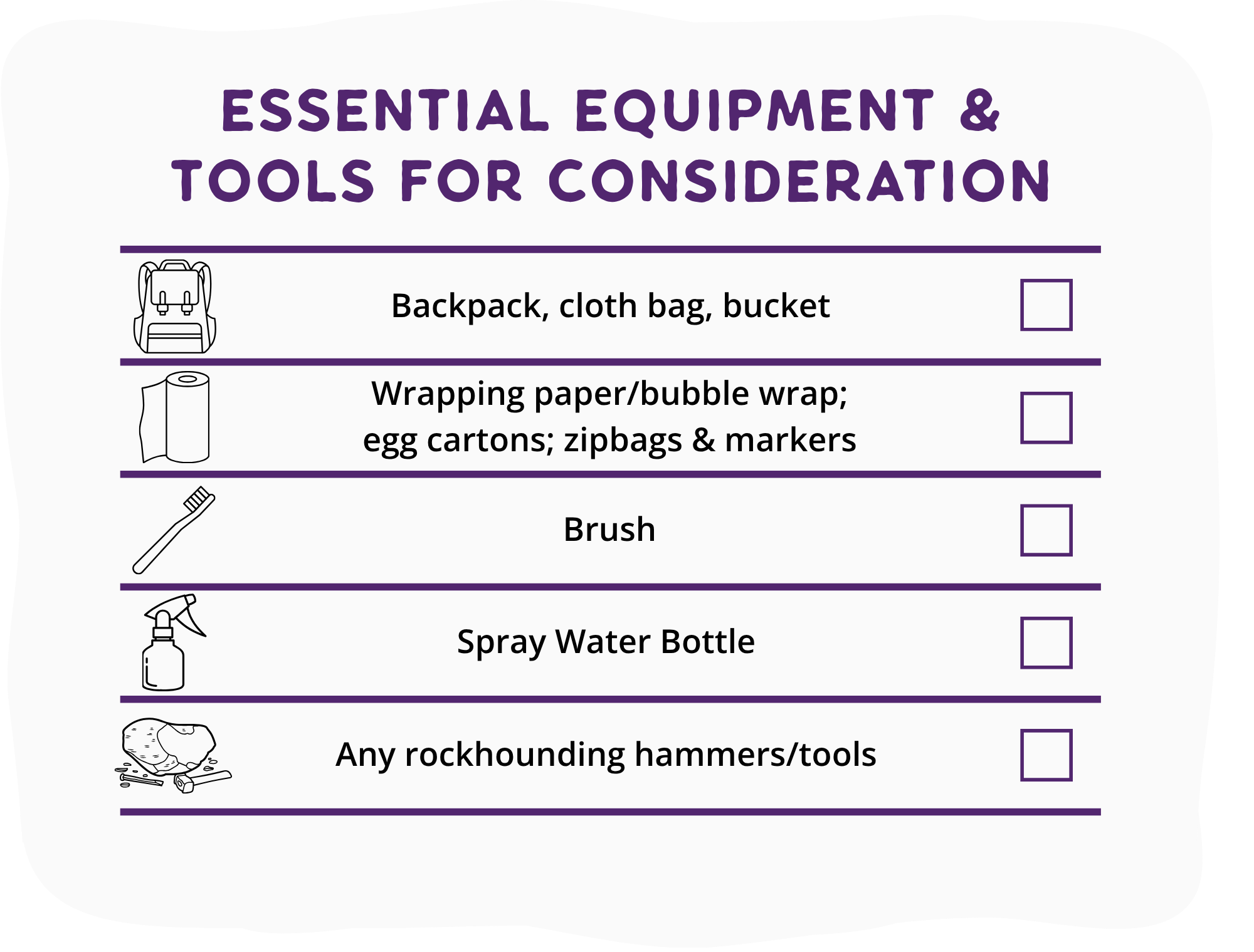Rockhounding Checklist: Dress for success to get started.
To get you started, we’ve put together a checklist of what you’ll need and why.

Description of image: Long pants (be ready for digging), Long sleeve shirt (sun and bug protection), Hat (sun, rain and bug protection), Rain jacket or foul weather gear, rain boots, Closed toed shoes (Hiking boots for ankle protection), Good socks, Sun screen lotion, Bug spray; Tick Remover, Container for collectables (cloth bag, backpack, bucket), Tools for digging (rock pick, shovel, trowel, hand cultivator) – see below further information, Safety glasses/goggles, First Aid Kit – include any allergy medications (epi-pen, etc.), Snacks & drinking water (snacking and staying hydrated are important
We recommend you be ready for the outdoors, for all weather patterns. This including digging & bugs and assuming there will be biting bugs.
Footwear: Closed toed footwear is a must to protect your feet. Good hiking boots provide protection, comfort and ankle support.
Outfit: Shirts, Pants, Hats & Jacket to provide: sun/rain & bug protection; stick protection; dirt protection. An extra pair of socks & footwear (can leave in a vehicle if you are not venturing too far off the road) Same goes for bringing along a change of clothing.
For Mineral Identification: Consider bring knife; magnet; jewellers loupe/magnifying tool
Navigation: Bring a map; GPS; Compass (be sure to know how to use it)
Snacks & drinking water: Nutrition & hydration are important while being out all day!
Safety & First Aid: Personal safety equipment as per the collecting site; a basic first aid kit & tick remover.
Important Note: It may be a bright sunny and warm day but be ready for the activity you are embarking upon. Hiking and/or collecting in sunny locations, (exposed rock piles, beaches, quarry sites), can expose you to the sun for extended periods of time. Clothing that protects you, along with sunblock lotion, is important. In the forest, the sun may not be a problem, however flying insects are likely to be lurking there. Limiting exposed skin and using bug spray are both good ideas. Everyone has different levels of tolerance to sun and insects. Keep your safety and comfort in mind.
Essential Equipment & Tools for consideration
Note: Geological tools are tempered harder than carpentry or masonry tools which can splay if you use these to strike rock, and flying metal is a dangerous situation. Please use tools as intended and always with caution. Be mindful of those around you.

Safety Glasses/Goggles: These are a must have if you intend to use any tool to strike rock. If you don’t have the safety equipment, don’t use striking tools. SAFETY FIRST.
Hammers: A rock hammer is a geological tool tempered hard enough to strike rock (it is not intended to use to strike another tool – if you have rock chisels, you will also need a 2 – 4 lb. crack hammer); a chisel hammer is a great addition as we do a lot of digging and prying.
Prybar: Depending on where you dig, at times a must have can be a prybar. It’s a long wrecking bar provides great leverage for moving boulders but can be unwieldy to carry long distance in the bush. A gad prybar is a smaller and handier tool to assist with breaking into fractured rock. Especially for fossil hunters looking to break into the rock layers, and useful in all collecting.
For Foraging/Prospecting: This activity often includes digging & breaking rock. We recommend to bring shovels, large & small; a prybar and a bucket/backpack to carry what you find.
For Quarry Collecting: First, make sure you have permission. Then wear a break away high visibility vest, an up-to-date safety helmet, steel-toed boots and safety glasses.
For Your Consideration: Trowels, shovels and rock chisels are generally available at hardware or building supply stores. Rock picks and other more specialized equipment is often available at rock shops – check online for one near you. Just about anything can be ordered online but take the opportunity to visit knowledgeable business owners in Hastings County and enjoy the advice and experience that can be offered by in person purchasing.
Important Things To Note
Facilities: There will be many trees and no facilities! KBYO. You will need to dig your own latrine; bring supplies including that small shovel, TP & hand sanitizer – pick a good tree to lean on. For more information on this topic see: How to Shit in the Woods 3rd Edition: An Environmentally Sound Approach to a Lost Art, by Kathleen Meyer
Location, location, location: It is of the utmost importance to keep track of the exact location of where you collect materials. This information can help with mineral identification and provides scientific significance. Without the location information, a specimen has no scientific value and less commercial value.
Cell phones: Keep in mind that reception may not work everywhere. Using a compass can be very handy, but one should be aware of magnetic declination for your location (check on-line), and the possibility of magnetic deflection from nearby iron deposits. GPS units are extremely handy for navigation, just make sure to carry extra batteries! It is easy to get lost, (especially on a cloudy day).
Hydrate: If you leave your car, take drinking water!
Ethics: Understand your responsibilities to collect ethically & legally. The Rockhounder's Code of Ethics emphasizes responsible and respectful mineral collecting, prioritizing landowner rights, environmental preservation, and ethical conduct within the hobby. It aims to ensure collectors act as stewards of the land, promoting safety, education, and positive public perception of the hobby.
Ontario's Ministry of Northern Development and Mines permits hobby mineral collecting as a recreational and educational activity, exercising "enforcement discretion" under the Mining Act. This policy allows individuals to collect minerals for personal enjoyment, education, or scientific purposes, provided they use only hand tools, limit their take to what one person can carry unassisted from a single site per year, and ensure they are collecting on land open to such activity.
Collectors must respect surface and mining rights, as unauthorized collection can lead to legal consequences like trespass charges.
The Ministry encourages responsible practices, emphasizing safety and environmental preservation, while generally refraining from enforcing standard mining regulations against those adhering to these guidelines.
Read more here: https://lakesidegems.com/blogs/news/rockhounding-101
